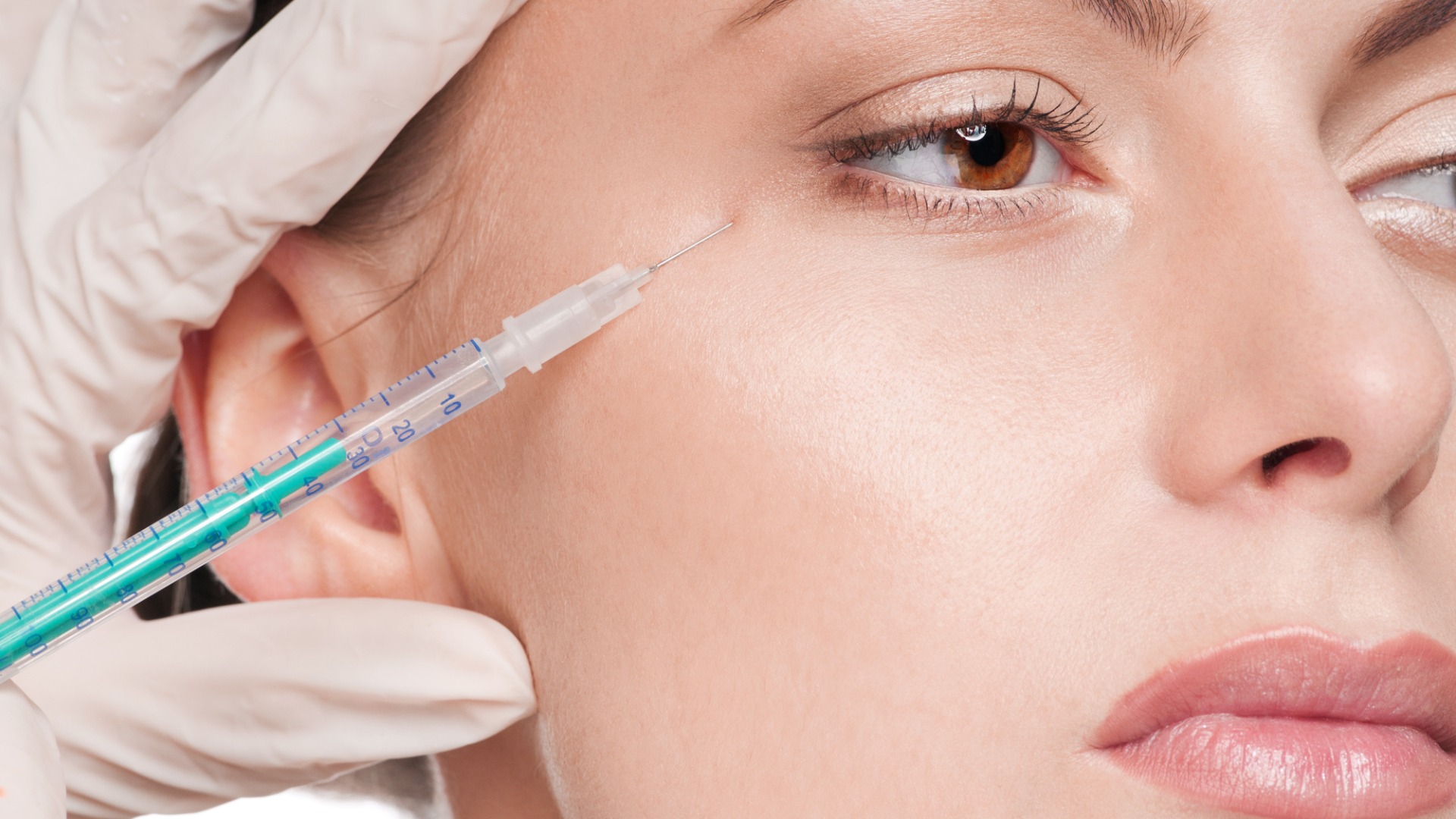help fill in wrinkles, add fullness to the face or lips, and achieve a natural rejuvenating effect through hyaluronic acid injection. Doctors adjust the dose and injection depth according to specific needs to achieve personalized enhancement.
What is Restylane
is an injectable dermal filler. Hyaluronic acid is the main constituent of this filler. Hyaluronic acid is a naturally occurring polysaccharide molecule. It is widely distributed in human connective tissue, epithelial tissue, and layers of the dermis. Hyaluronic acid absorbs and locks a large amount of moisture, which makes skin elastic and hydrated. As age factor advances, hyaluronic acid in the body gradually decreases, leading to reducing skin elasticity, giving rise to wrinkles. Restylane cross-links hyaluronic acid of specific molecular sizes into a gel-like filler that is injected into the various depths of the dermal and subcutaneous layers, depending on indications, for volume restoration, filling wrinkles, and lifting facial contours.
Restylane represents a family of fillers made up of many different cross-linking structures of hyaluronic acid and different gel densities to meet the needs for different indications and skin conditions. For example, Restylane-L is indicated for the treatment of moderate to deep wrinkles and facial folds, such as nasolabial folds and tear troughs. Restylane Silk is indicated for lips and perioral rhytides. Restylane Lyft is specially prepared with a more dense gel and therefore may be used in very deep injections for accentuating the cheeks or for contouring. Depending on the patient’s needs and the special features of the area, different types of products from Restylane can be selected. This provides an aesthetic solution on an individual basis.
Uses of Restylane
Restylane applications cover various facial and non-facial areas, going beyond wrinkle filling to improve overall skin rejuvenation. Specifically, Restylane is suitable for:
-
Deep Filling and Facial Contouring: Deep filling with Restylane fillers can serve to support sunken areas in the subcutaneous layer, allowing lifting and contouring effects. Examples include augmenting the cheeks, contouring the jawline, and filling the chin. Injections of higher-density products like Restylane Lyft will give added facial contours more clarity and definition.
-
: Such common dynamic wrinkles include nasolabial folds, marionette lines, and crow’s feet, which can be filled with Restylane through dermal injections. Dynamic wrinkles are due mostly to muscle contractions combined with skin aging, and hyaluronic acid in Restylane fills such wrinkles, maintaining skin elasticity and hydration for lasting effects through its water-locking function. Fine to moderate dynamic wrinkles can be treated with Restylane Refyne and Defyne, which blend easily with the skin to create a natural and seamless appearance.
-
Lip Enhancement: Lip volume can be enhanced with Restylane injections, reshaping lip contours to make them fuller and softer. As the age factor advances, sagging occurs in the skin of the lips with the result that fine vertical lip lines appear. Lip lines and perioral rhytids improve with Restylane injections. The finer hyaluronic acid filler is Restylane Silk, prepared especially for enhancing the fullness of the lips and adding a refined soft structure to the lips.
-
Improvement of Tear Troughs and Dark Circles: Restylane also works wonderfully on tear troughs. Tear troughs are bony depressions that occur due to a loss of volume in the fat layer sandwiched between the skin around the eye and deeper facial tissue. Hyaluronic acid in Restylane fills such depressions, which reduces shadowing and hence dark circles. Treatment, however, requires great attention to anatomical structure through gentle injection to prevent superficial swelling, which ensures natural fill.
-
Skin Enhancement in Non-Facial Areas: Besides the face, Restylane fillers can be used for the back of hands and the neck, which generally have thinner skin and show more signs of aging. Restylane injections fill depressions at the back of the hand to give it a more youthful look.
Benefits of Restylane
Restylane, based on hyaluronic acid, has a structure that is in consonance with the body’s natural hyaluronic acid, so it is less likely to cause adverse reactions. Using NASHA™ technology (Non-Animal Stabilized Hyaluronic Acid), Restylane ensures high purity and stability, slowing its degradation in the body and making the effects last longer. Unlike some permanent fillers, Restylane’s effects are reversible, gradually absorbed and metabolized within 6 to 18 months, giving patients more confidence in its effects and safety.
Restylane injections are very natural. Given the series’ availability of different textures and densities of gels, it adapts better to facial dynamics, avoiding stiffness or unnatural expressions of the face. Especially for fine lines in the mid-to-superficial layers, softer Restylane products blend in perfectly with the skin, thus allowing smooth, non-rigid expressions.
The water-locking function significantly improved the skin condition of Restylane. Hyaluronic acid is an active moisturizing ingredient, and the injection of Restylane can absorb and retain moisture in it, making the skin surface much smoother and more shining. Such moisturizing effect will last as long as the existence of the filler in skin, keeping the skin healthy and young.
Restylane for Wrinkles
Restylane is most commonly used to treat dynamic and . Dynamic wrinkles generally occur due to repeated contractions of muscles, while the most common are forehead lines and frown lines. Static wrinkles involve loss of collagen, elastic fiber breakage, and sagging of skin, which includes nasolabial folds and marionette lines. Restylane fillers can effectively enhance both types of wrinkles by making injections at varying depths.
In deeper static wrinkles, such as nasolabial folds, the doctor might use a thicker product to provide support for the deep skin layer, like Restylane Lyft. Such treatments definitely demand precision in regulating depth and dose to achieve a natural fill without affecting facial muscles.
For crow’s feet and fine lines at the periphery of the eye, this becomes somewhat more complicated, given that the thin, sensitive skin around the eye requires softer fillers like Restylane Silk injected superficially. Physicians use either point or linear filling techniques according to facial anatomy and the distribution of wrinkles to balance out the distribution of the filler, thus smoothing out fine lines. Injections should avoid main vessels because of the rich vascular supply around the eyes, in order to ensure safety with effectiveness.
For the treatment of nasolabial folds and marionette lines, physicians may choose medium-density products such as Restylane Refyne or Defyne. These products allow flexibility post-injection, blending in with skin dynamics and helping to fill noticeable moderate wrinkles.
Lip Enhancement
Restylane is flexible and customizable for lip enhancement. Lip enhancement could mean the building up of volume to define shape and contour for full and layered lips. Usually, physicians would assess the structure of the lips before injection and come up with an individual plan, which could be enhancing the cupid’s bow or accentuating the lip line.
Physicians usually prefer Restylane Silk, as this is softer and naturally distributes to even out lips without stiffening them after the procedure. In fact, doctors may suggest Restylane Kysse to people who are looking for a truly puffy appearance; this gives more excellent results in terms of longevity and feel of the natural lip.
Lip injections are all about precision in technique. The lips house a dense vessel structure and complex anatomy, hence requiring skillful handling of the needle for uniform injection. Doctors often perform multiple injections into the lip line, philtrum, and cupid’s bow; treatment dosage is adjusted to lip dynamics for natural, soft enhancement.
Side Effects
Although Restylane injections are minimally invasive, there are still several adverse reactions that may occur. Inflammation due to capillary rupture from the needle puncture and injection of the filler may cause temporary redness, bruising, and mild pain at the site of injection, which usually resolves in hours to days.
More serious but less common side effects include vascular occlusion and . Hyaluronic acid may exert local tissue ischemia or even necrosis in case it had accidentally entered the blood vessels. This risk can be minimized with skilled operation and avoiding key blood vessel paths. Another risk of Restylane injection is allergic reaction. Although hyaluronic acid itself is not highly allergenic, cross-linking agents or other components may cause allergy to some patients. Doctors usually ask about the history of allergy and may carry out skin tests when necessary for safety.
Treatment Process
The Restylane treatment process generally involves three main steps: facial assessment, injection preparation, and injection operation.
The first step is the facial assessment phase. Doctors will inquire about the needs and expectations of the patient, estimate the facial bone structure, the thickness of the skin, wrinkle depth of the patient, and formulate an injection plan. The doctor will determine the layer of injection, the dose, and product type according to the specific anatomical position and wrinkle distribution.
Physicians would then clean up and disinfect the area, and apply local anesthesia, as needed. Most of the Restylane products contain a minimal quantity of lidocaine to reduce pain at the site of injection. For those who have a low pain threshold, the physician may apply anesthetic cream prior to injection to further reduce discomfort.
In reality, doctors use fine needles or blunt needles, depending on the indication and needs of the area and skin layer, to perform layered and point-by-point injections. According to product characteristics and area needs, doctors adjust the injection techniques for the purpose of even distribution to avoid lumps and unevenness





